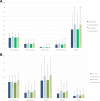Epidemiology of Injuries Identified at the NFL Scouting Combine and Their Impact on Performance in the National Football League: Evaluation of 2203 Athletes From 2009 to 2015
- PMID: 28812033
- PMCID: PMC5529031
- DOI: 10.1177/2325967117708744
Epidemiology of Injuries Identified at the NFL Scouting Combine and Their Impact on Performance in the National Football League: Evaluation of 2203 Athletes From 2009 to 2015
Abstract
Background: At the annual National Football League (NFL) Scouting Combine, the medical staff of each NFL franchise performs a comprehensive medical evaluation of all athletes potentially entering the NFL. Currently, little is known regarding the overall epidemiology of injuries identified at the combine and their impact on NFL performance.
Purpose: To determine the epidemiology of injuries identified at the combine and their impact on initial NFL performance.
Study design: Cohort study; Level of evidence, 3.
Methods: All previous musculoskeletal injuries identified at the NFL Combine from 2009 to 2015 were retrospectively reviewed. Medical records and imaging reports were examined. Game statistics for the first 2 seasons of NFL play were obtained for all players from 2009 to 2013. Analysis of injury prevalence and overall impact on the draft status and position-specific performance metrics of each injury was performed and compared with a position-matched control group with no history of injury or surgery.
Results: A total of 2203 athletes over 7 years were evaluated, including 1490 (67.6%) drafted athletes and 1040 (47.2%) who ultimately played at least 2 years in the NFL. The most common sites of injury were the ankle (1160, 52.7%), shoulder (1143, 51.9%), knee (1128, 51.2%), spine (785, 35.6%), and hand (739, 33.5%). Odds ratios (ORs) demonstrated that quarterbacks were most at risk of shoulder injury (OR, 2.78; P = .001), while running backs most commonly sustained ankle (OR, 1.39; P = .040) and shoulder injuries (OR, 1.55; P = .020) when compared with all other players. Ultimately, defensive players demonstrated a greater negative impact due to injury than offensive players, with multiple performance metrics significantly affected for each defensive position analyzed, whereas skilled offensive players (eg, quarterbacks, running backs) demonstrated only 1 metric significantly affected at each position.
Conclusion: The most common sites of injury identified at the combine were (1) ankle, (2) shoulder, (3) knee, (4) spine, and (5) hand. Overall, performance in the NFL tended to worsen with injury history, with a direct correlation found between injury at a certain anatomic location and position of play. Defensive players tended to perform worse compared with offensive players if injury history was present.
Keywords: National Football League; epidemiology; football (American); injury rate.
Conflict of interest statement
One or more of the authors has declared the following potential conflict of interest or source of funding: M.T.P. is a consultant for Arthrex and the Joint Restoration Foundation (Allosource) and receives royalties from Arthrex and SLACK Inc.
Figures







References
-
- Aune KT, Andrews JR, Dugas JR, Cain EL. Return to play after partial lateral meniscectomy in National Football League athletes. Am J Sports Med. 2014;42:1865–1872. - PubMed
-
- Brophy RH, Barnes R, Rodeo SA, Warren RF. Prevalence of musculoskeletal disorders at the NFL Combine—trends from 1987 to 2000. Med Sci Sports Exerc. 2007;39:22–27. - PubMed
-
- Brophy RH, Chehab EL, Barnes RP, Lyman S, Rodeo SA, Warren RF. Predictive value of orthopedic evaluation and injury history at the NFL combine. Med Sci Sports Exerc. 2008;40:1368–1372. - PubMed
-
- Brophy RH, Gill CS, Lyman S, Barnes RP, Rodeo SA, Warren RF. Effect of anterior cruciate ligament reconstruction and meniscectomy on length of career in National Football League athletes: a case control study. Am J Sports Med. 2009;37:2102–2107. - PubMed
-
- Brophy RH, Lyman S, Chehab EL, Barnes RP, Rodeo SA, Warren RF. Predictive value of prior injury on career in professional American football is affected by player position. Am J Sports Med. 2009;37:768–775. - PubMed
LinkOut - more resources
Full Text Sources
Other Literature Sources

